Content
- What it is
- Causes and manifestations of the "frog belly"?
- Classification
- Complications
- What to do?
- Drug treatment
- Exercises
- Experienced doctors advice
- Video about rickets
The beginning of the formation of a new organism falls on the moment of fertilization of the egg. Development processes continue in the first years of life. Parents of newborns need to pay attention to their appearance and compliance with the norms of the postnatal period. Sometimes a child has a "frog belly" which denotes a special state of the body.
What it is
The condition is characterized by weak muscles in the abdominal walls. It is manifested by a flat appearance of the tummy, which protrudes on the sides when the child is in the supine position. In this case, the abdomen takes on a rounded shape, hanging down at the sides, and remains flat in the frontal region.
Weak muscle syndrome occurs due to vitamin D deficiency and a baby's sedentary lifestyle. In the first years of life, in itself, it is not a pathology and passes over time. However, if other abnormalities and symptoms are observed, then pediatricians and surgeons correlate the "frog belly" with a disease called rickets.
In addition to the above symptom, this pathology is accompanied by other symptoms:
- restlessness and sleep disturbance;
- mood swings;
- frequent tearfulness, irritability;
- increased sweating;
- late onset of eruption of milk teeth.
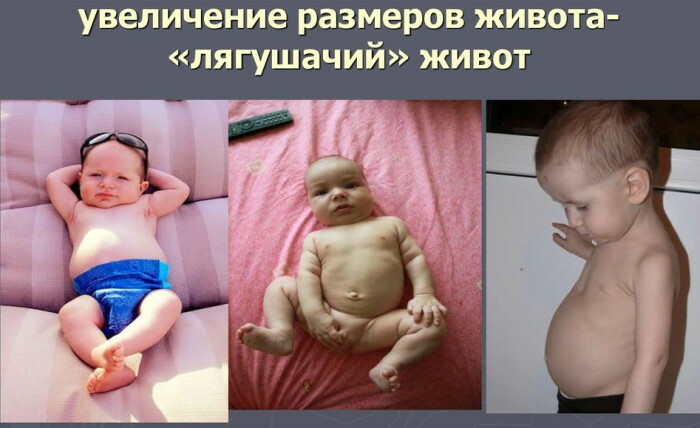
However, with rickets, muscle weakness is observed not only in the abdomen. Also, such violations are noted on the upper and lower extremities. Rickets is a pathology that can lead to the curvature of the muscles of the arms and legs of the child, to disruption of the functioning of internal organs and systems.
If a mother notices such deviations in her child in combination with other signs, then she needs to seek advice from a pediatrician or surgeon. Timely treatment and diagnosis followed by therapy give excellent chances for a speedy recovery.
Causes and manifestations of the "frog belly"?
A "frog belly" in a child most often indicates his normal development. Babies look different from birth. Some babies up to a year have a plump appearance, they have a bulging tummy, which does not cause fear in parents. Other babies differ in model shapes, they are thin, and when they have a big belly that protrudes, then this leads to anxiety in the parents. Basically, this condition does not apply to pathologies.
In infants, the tummy is flattened in a supine position on the back and hangs down on the sides due to hypotension of the abdominal muscles. It also increases after eating. The condition goes away by the age of 3, when the abdominal muscles are tightened and it becomes flat. Maintaining a mobile way of life contributes to this. To prevent the appearance of pathologies, pediatricians recommend that parents carry out gymnastic exercises on the ball with infants and do massages.
Additional signs (mood swings, deterioration in well-being) indicate any deviations from the developmental norm. If by the age of 2 years the condition does not go away, then this should cause concern.
Rickets is a disease that occurs in fast growing children. It is associated with metabolic dysfunction and vitamin D deficiency. Pathology affects the bone, nervous system and internal organs. The disease has been known since ancient times.
It was described by the scholars Galen and Sorom of Ephesus. In the paintings of European artists of the 15th-18th centuries. many images of children showing signs of rickets are captured: flattened nape, "frog stomachs", twisted arms and legs.
According to statistics, the disease affects from 20 to 60% of children in Russia. It is especially relevant for those who live in the northern regions and in large metropolitan areas with poor environmental conditions. Children from rural areas, southern regions, the disease affects less often.
The cause of the disease is a lack of vitamin D (calciferol). The peculiarities of a useful substance is that when its components enter the body with food, then vitamin can be formed only under the influence of sunlight or artificial ultraviolet irradiation.
The functions of calciferol include:
- regulation of metabolic processes for the assimilation of calcium and phosphorus (they are necessary for the correct formation of bone tissue);
- accelerating the absorption of these minerals by the intestines from food;
- deposition of trace elements in the bones.

Frog belly in a child
The following reasons for the appearance of rickets are known:
- Lack of sunlight or ultraviolet radiation. This explains the fact that the disease mainly develops in the autumn-winter period.
- Lack of vitamin D, which enters the body with food, as well as calcium and phosphorus in the diet.
- Treatment with anticonvulsants.
- The presence of intestinal pathologies, in which the absorption of vitamin D into the body is impaired.
Vitamin D deficiency is common in early childhood. The initial signs of the disease are associated with disturbances in the functioning of the nervous system, which are manifested by the following symptoms:
- poor sleep (intermittent, superficial);
- an increase in the number of tantrums, tears;
- irritability;
- the appearance of profuse sweating;
- baldness of the back of the head;
- late closure of the fontanelle;
- deviation from the temporary norms for the eruption of milk teeth.
Sweating manifests itself as a "wet pillow" syndrome, when a wet spot is observed on it after a child's sleep. Increased discharge from the sebaceous glands can irritate the skin, and this leads to anxiety in the child.
Hair is downloaded and wiped off at the back of the head when turning the head. The dentition erupts in the wrong order. In the further development, tooth enamel is affected by caries. There is a possibility of the formation of hypoplasia - the destruction of bone tissue.
Classification
A "frog belly" in a child may indicate a dangerous disease of rickets. The classification of the degrees of its severity with a description of the symptoms is summarized in the table.
| Degree | Description |
| First easy | This is a condition with mild pathologies in the nervous and skeletal systems. To a greater extent, the work of the nervous apparatus is disrupted. The signs are as follows:
|
| Second middle | The degree has pronounced pathologies in the nervous and musculoskeletal system. Sometimes an enlarged liver, spleen and low hemoglobin are diagnosed. The general condition worsens, deviations appear in the respiratory and cardiovascular systems, in the digestive tract. The onset of the second degree is established after 1.5-2 months from the appearance of the first signs of the disease. Usually the diagnosis is made at 4-5 months of age. It manifests itself in symptoms:
|
| Third heavy | The degree is characterized by severe disorders in the nervous and skeletal system, in the internal organs. It manifests itself in the following signs:
All disorders in the nervous system, muscle and bone tissues lead to abnormalities in the work of internal organs. Defects in respiratory function are observed (shortness of breath appears), deformation of the chest, hypotension of the diaphragm. Rickets are often accompanied by pneumonia. The work of the heart is impaired (tachycardia, weakening of heart sounds, systolic murmur). There is a stagnation of blood in the liver and an increase in its size, as well as a thickening of the spleen, hypochromic anemia, and a change in the structure of erythrocytes. |
Complications
"Frog belly" in a child, which is part of the complex of rickets symptoms, must be treated. If you do not engage in therapy, then in the future manifestations of the disease spread to all bone tissues: to the chest, upper and lower extremities, skull and spine.
The following disorders of bone development are observed:
- "X-shaped" or "O-shaped" lower limbs.
- Curvature of the pelvic bones (in a girl, they can lead to an obstacle to the conduct of normal natural childbirth).
- The "Olympic forehead" is the pronounced frontal tubercles that appear through the softening and malleability of the bones of the skull. In this case, the head becomes disproportionately large.
- The so-called "rickets rosary" is the compaction of the ribs in the places where they pass from bone to cartilaginous tissue.
- The depressed lower sternum or "shoemaker's chest". In severe forms of the disease, there is an external protrusion of the bones ("chicken breast").
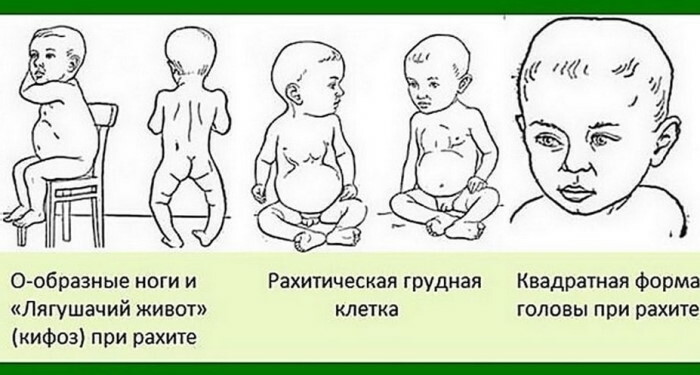
If the disease is not stopped, then it goes on to damage the internal organs: liver, spleen.
Then the following symptoms are noted:
- gag reflex after eating or regurgitation;
- persistent abdominal pain;
- stools in the form of diarrhea or constipation;
- an increase in the size of the liver;
- pale cyanotic skin that appears as a result of hemoglobin deficiency.
The disease often leads to delays in the development of the child. He may later begin to hold his head, sit down, stand up, crawl, or walk. There are cases of rickets in a child over a year old, when he has already begun to walk. Due to pathology, this developmental skill disappears.
In no case should the disease be triggered, since its consequences remain for life. Then they can lead to the development of scoliosis, flat feet, the appearance of a flat pelvis, curvature of the legs, and already at school age, myopia can form.
What to do?
Complex treatment includes the following procedures:
- vitamin therapy;
- massage and gymnastics;
- taking baths;
- stay in the fresh air.
The therapeutic effect is observed only in those cases when vitamin therapy provides the child with the necessary amount of calcium and phosphorus salts. It should be combined with normal sleep patterns, water treatments and outdoor walks.
It is necessary to introduce more vegetable and fruit juices, mashed potatoes into the diet, limit the use of cereals and flour products. Proper nutrition of a child from the first days of life is an important factor in the prevention of rickets.
Vitamin D should be administered from the moment of birth, regardless of the type of feeding. During the period of treatment, the dose of the drug is increased.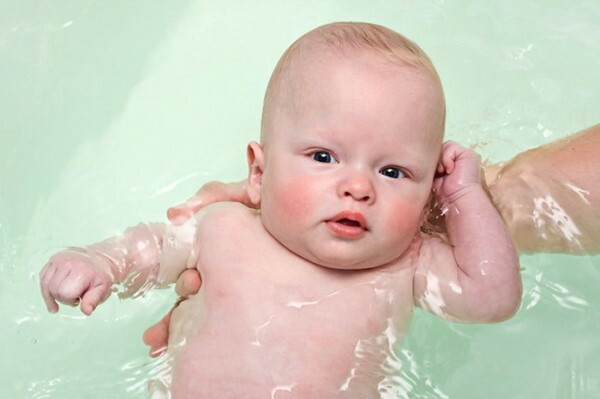
Additional methods of therapy are salt and pine baths. The salt bath is prepared for 1 bucket of water 10 g of salt (it is allowed to use both sea and table salt). Such procedures can be performed on children after 6 months.
The bathing schedule is as follows:
- The initial water temperature should be between 36-37 ° C.
- The indicator should be gradually reduced to 32 ° C. If the child is over 1 year old, then the temperature drops to 30 ° C.
- The duration of the bath is 3-5 minutes.
- After the procedure, the child is rinsed under fresh water.
- The course of treatment takes 10-15 baths, which are carried out every other day.
Coniferous fonts are prepared at the rate of 1 bucket of water 0.5 tbsp. l. coniferous extract. They are carried out in the same way as saline. Only the duration of the bath changes. It is 5-10 minutes. Salt baths are recommended for restless children leading an active way of life, and coniferous ones, on the contrary, are intended for babies with reduced activity.
Drug treatment
A child's "frog belly" caused by rickets is treatable. The drug therapy includes taking vitamin preparations.
Vitamin D (solution of ergocalciferol or cholecalciferol) can be used as follows:
- 0.5% alcohol solution, 1 drop of which contains approximately 4000 IU;
- 0.0625% oil solution in 1 ml of 25000 IU;
- 0.125% oil solution in 1 ml of 500 IU.
There are other products on sale in pharmacies:
- Vigantol is an oily solution of vitamin D3, which contains 600 IU in 1 drop.
- Videin is a tablet preparation, where 1 unit contains vitamin D3 in the amount of 2000 IU or 5000 IU.
- Vitamin D metabolites are Alfacalcidol, Oxydevit, Etalfa.
To prevent the disease, children are prescribed the drug at a dose of 1000 IU per day. If a child is artificially fed with milk formulas, then it is necessary to ensure that the dose is not exaggerated, since they also contain vitamin D3. In such cases, the prophylactic dose should be equal to the total (from the mixture and the drug). If it is impossible to calculate the dosage that the child takes with food, then the intake of calciferol should be reduced to 500 IU per day.
Children who have expressed hypocalcemic signs of rickets, that is, osteomalacia in the form of curvature of the legs, are shown calcium supplements taken for 2-3 weeks.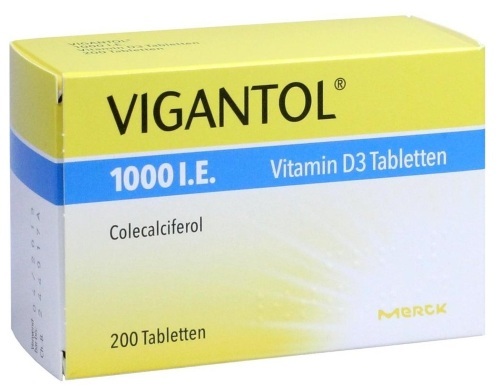
When the disease is accompanied by malnutrition, then in addition, specialists prescribe orotic acid (potassium orotate) at a dosage of 20 mg per 1 kg of body weight for 3-4 weeks. The complex treatment of rickets includes drugs that contain magnesium. A number of such medicines include Asparkam, Panangin or 1% magnesium sulfate solution at a dosage of 10 mg per 1 kg of body weight. The course of therapy is 3 weeks.
Exercises
Frog belly can be tightened with exercise. The medical complex of measures for the child must include massage and gymnastics. The procedures are well combined with the use of Proserin (at a dose of 0.01% solution for each year of life intramuscularly for 10 days) and Dibazol (0.01 g once a day for 20 days).
The set of exercises includes the following manipulations:
- A stroking massage of the lower extremities, which is carried out with the child lying on his back with the legs towards the parent. The baby's left foot must be taken with the left hand, and with the right palm, stroke the outer and inner sides of the knees and thigh. The same is done with the right leg.
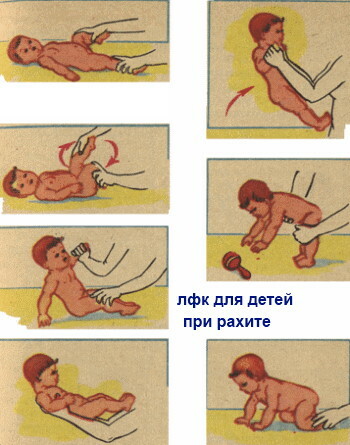
- Flexion-extension of the arms, in a sitting position, when the child is allowed to hold onto the ring, which the parent pulls towards him. Then the hand changes.
- Flexion and extension of the legs is carried out in the knee, hip and ankle joints. The parent squeezes and straightens the baby's legs alternately. The exercise is performed slowly at first, gradually accelerating.
- The abdominal massage is done in the initial position of the child lying on his back with the legs towards the parent. With the palms of both hands, he strokes the muscles of the tummy in an up and down direction.
- Rubbing the oblique and transverse muscles is done with the palms of both hands when they converge at the navel.
- Circular movements of stroking the tummy in a clockwise direction.
You can do it with a three-month-old baby. It is recommended to repeat each exercise 2-3 times. The use of general massage techniques for rickets should be determined on a strictly individual basis. Exercises are prescribed depending on the severity of the disease and the age of the child.
Breathing exercises should also be included in gymnastics, the essence of which is light palm pressure on the baby's chest. Crossing and pressing the handles to the chest can be done as the baby gets used to gymnastics.
Experienced doctors advice
Pediatricians and surgeons advise to prevent the disease before it appears.
The list of measures includes:
- Need constant intake of vitamin D3 by pregnant women.
- It must be remembered that children who are fully breastfed after 6 months are at a special risk group with a high probability of illness.
- An additional factor that increases the possibility of developing the disease is a dark skin color. These children need a double dose of the vitamin.
- A child's intake of vitamin D every day at a dose of 500-1000 IU up to the age of 3 years, timely and correct administration complementary foods, starting with vegetable purees, constant daily walks in the fresh air serve as prevention pathology.
- The rate of intake of calcium and phosphates with food is ensured by taking 2-3 servings of dairy products. One serving is 1 glass of milk, a jar of yogurt, or a slice of cheese. If your child has an allergic reaction to dairy products, alternatives should be discussed with a dietitian or pediatrician.
- The list of foods rich in vitamin D includes: oily fish (mackerel, salmon), liver, some mushrooms, and egg yolks.
- There are a number of products on the market in which vitamin D is artificially added. However, with food, you can get a small amount of the daily requirement for it (about 10%). The rest of the portion is produced in the skin under the influence of sunlight or ultraviolet radiation.
Frog belly in children is not always a sign of illness. For most babies, the condition goes away on its own without complications. Only in combination with other symptoms can it indicate pathological processes, the development of rickets.
Video about rickets
Komarovsky about rickets and vitamin D:
